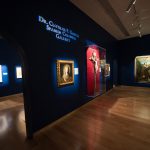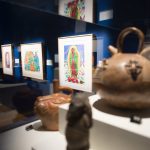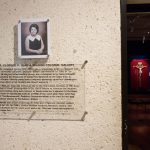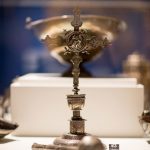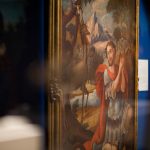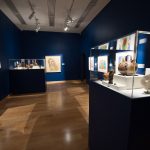06/01/2016
Glass,
Oil Paintings,
Prints,
Sculptures
Spanish Colonial Gallery
The Art Museum of South Texas (AMST) opened its first permanent exhibition, The Dr. Clotilde “Dr. Cleo” P. Garcia Spanish Colonial Gallery, on May 22nd, 2016 showcasing many Spanish Colonial, pre-Columbian, and contemporary works inspired and influenced by artisans and artists of that time. With a generous contribution for the J.A. “Tony” Canales Family, AMST now has this valuable cultural resource which features works of art spanning the Pre-Columbian and the Spanish Colonial period in Central America, Mexico, and the Southwestern United States (which was known as New Spain), and Peru (which encompassed all of South America except for Brazil. The pieces within the exhibition reflect how the Spanish Colonial period was a time of conquest, change, and influence.
Q&A with Barbara Canales
from the AMST Q3, 2016 Newsletter
AMST is dedicated to advancing the awareness, knowledge, appreciation, and enjoyment of the visual arts for the residents and visitors of South Texas by actively collecting, conserving, exhibiting, researching, and interpreting outstanding works of visual art with particular interest in Art of the Americas and the region. In fulfillment of this mission, AMST opened the first permanent exhibition gallery dedicated to the subject of Spanish Colonial and Pre-Columbian art with a generous contribution for the J.A. “Tony” Canales Family. AMST Director Joe Schenk recently spoke with Barbara Canales about the exhibition’s importance to the South Texas community.
Why is it important for the community to have access to Spanish Colonial art at our Museum?
It is important to have access to Spanish Colonial art because it is our history. The Art of the Americas is a representation of the period in time where the Spanish Empire colonized most of Central and South America as well as the Southwest region of the United States. To be able to view this art is not only the obvious lesson in art history, but also a richer lesson in religion, culture, politics and philosophy. We are so highly influenced by the period of Spanish conquest that our cities, towns, rivers, bays, geographical, and geological landmarks all bear names and influence of Spanish origin. The Spanish language, literature, music, dance, and architecture along with the Catholic religion not only have survived, but dominated the centuries amidst other foreign and Native American influences throughout Central and South America. The Spanish Colonial art provides a rare glimpse to the past and tells a story of the importance of religious dominance during the timeline from the 1500’s to the early 1800’s.
Can you tell us about the Canales family’s commitment to the Museum and vision for this new gallery?
The Canales Family is committed to bring you a world class gallery where paintings, textiles and objects of the Spanish Colonial Period is represented. Over time, objects such as furniture and silver will join the collection. Complementing the incredible oil paintings will be textiles and objects used for religious purposes. It was important to the Canales Family to provide an overall ambiance for this art that had that right feel for a first time or repeat visitor. Particular care has been given to the concept of a warm jewel toned wall, arched cased openings, a wood floor and, in the future, featured Iron Gate entrance. Of course, of equal importance, is the specialty framed lighting highlighting the art, and the curated descriptions of each art piece. This gallery is the result of many wonderful donors and visionaries; however it is filled with love and respect for the past and dedicated to Dr. Clotilde P. Garcia, loving mother and grandmother of the Canales Family.
Dr. Cleo was an extraordinary woman –what can you tell us about her interests in art, history and museums?
Dr. Cleo dedicated much of her time outside her medical career as an author, historian and archaeologist. She devoted herself to researching the History of South Texas, and her work in the arena of Spanish Genealogy is widely recognized today as pioneering for those South Texas families with a Spanish surname. Her home was a reflection of all she loved. Art was in abundance, from oil paintings to works in bronze and stone. There were Spanish books of antiquity, old Colonial keys, Indian clay pottery, and arrowheads, Spanish maps, and lots of Mexican birth and death certificates. At all hours there was the clicking of the typewriter and mounds of paper at her side. You could open most any drawer in her room and find old Spanish and Mexican currency and stamps.
She loved all mediums of art and painted herself in acrylic preferring the palette knife as her instrument of choice. She was a walking history professor and loved to frequent museums. The highlight of her life she said was being able to travel to Madrid with her grandchildren.
Dr. Clotilde P. Garcia Spanish Colonial Gallery – FAQs
What artwork and artifacts make up the Spanish Colonial Collection?
The collection is made up of Spanish colonial paintings, silver and textiles; Pre-Columbian pottery, sculpture and artifacts; and contemporary works of art by Hispanic artists that draw their inspiration/influence from either Spanish Colonial or Pre-Columbian material.
What is the Origin of the Spanish Colonial Exhibition?
The collection is made up of purchases and/or gifts from foundations, individuals, or corporations made to the Art Museum of South Texas.
How Long is the Spanish Colonial Exhibition on Display?
These galleries are permanently on view. Other works will be added in the future as well as some rotation of other objects from the permanent collection will occur.
What criteria was considered for lighting the exhibition?
The lighting concepts were to utilize framing projectors to specifically highlight the works of art, use only LED lighting for the protection of the art, and create a space that was both intimate and reverent.
Who designed the exhibition Gallery?
Gallery spaces were conceived, designed and installed by the Art Museum’s staff.
From concept to completion, what was the Timeline for the Spanish Colonial Exhibition?
The gallery concept was set forth over 12 years ago, but execution occurred over the past three years. The Exhibition opened to the public on Tuesday, May 24, 2016.
Interviews
Listen to local NPR Station KEDT’s radio personality, Liz Laubach, interview Barbara Canales on air on July 5, 2016
Accessibility Information
Photo Restriction: Photography allowed in the exhibition (no flash, no tripods)
Touch Restriction: Non-touch exhibition
Exhibition Language(s): English (Spanish translations coming soon)
Potential Challenges for Visitors With:
- Visual Impairment – Low light levels
- Specific Religious Beliefs – Artwork includes religious imagery
Other Notes:
The art and artifacts in this gallery space must be presented with low levels of light. Please navigate this darker than normal gallery space with care.
For questions or more information, please contact: clayton.reuter@tamucc.edu

